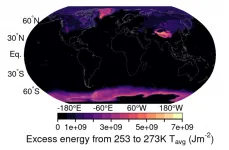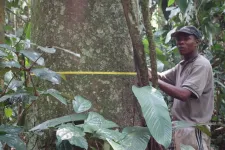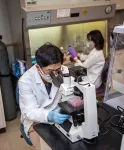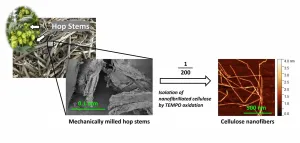Solar hydrogen for Antarctica -- study shows advantages of thermally coupled approach
A team from the Helmholtz-Zentrum Berlin, Ulm University, and Heidelberg University has now investigated how hydrogen can be produced at the South Pole using sunlight, and which method is the most promising
2021-07-02
(Press-News.org) When environmental physicist Kira Rehfeld, from Heidelberg University, visited Antarctica for her research, she was struck by the intense light there. "It's always light in summer. This solar radiation could actually be used to supply the research infrastructure with energy", she observes. However, generators, engines, and heaters in these remote regions have mostly been powered until now by fossil fuels delivered by ship, such as petroleum or petrol, which cause global warming. Besides the high associated economic costs, pollution from even the smallest spills is also a major problem threatening the especially sensitive ecosystem.
Fossil fuels could be replaced by hydrogen, though, a versatile energy medium that in addition is able to be stored extremely well at low temperatures. "Our idea was therefore to use solar modules to produce climate-neutral hydrogen on site during the Antarctic summer by splitting water into hydrogen and oxygen through electrolysis", says May, then a postdoc at the Helmholtz-Zentrum Berlin Institute for Solar Fuels. Rehfeld and May applied for funding from the Volkswagen Foundation to investigate whether hydrogen can be generated using sunlight even at sub-zero temperatures, and which method is best suited for this. Low temperatures can considerably reduce the efficiency of electrolysis, though cold actually increases the efficiency of most solar modules.
May and his HZB colleague, Moritz Kölbach, have now empirically compared two different approaches: a conventional setup in which the photovoltaic module is thermally and physically separated from the electrolysis tank, and a newer, thermally coupled setup in which the photovoltaic module is in close contact with the wall of the electrolysis tank, promoting thermal diffusion. To simulate Antarctic conditions, Kölbach obtained a freezer, cut a hole in the door, installed a quartz window, and illuminated the inside of the cabinet with simulated sunlight. He filled the electrolysis container with 30 per cent sulphuric acid (also known as battery acid) that has a freezing point around -35 degrees Celsius and conducts electricity well.
Kölbach then set up the experimental cells, and carried out the series of measurements. During operation, it became apparent that the cell with the thermally coupled PV modules produced comparatively more hydrogen, since the illuminated PV modules pass their waste heat directly to the electrolyser. "We were even able to increase the efficiency by adding additional thermal insulation to the electrolyser. As a result, the electrolyte temperature climbed during illumination from -20 to as high as +13.5 degrees Celsius", says Kölbach.
The results of this study confirm that thermally coupled systems have potentially higher efficiency than thermally decoupled ones. Whether these advantages can be exploited economically, however, remains to be seen. "Therefore, in the next phase we want to test prototypes under realistic conditions. That will certainly be exciting and we are currently looking for partners for this", says May.
Locally generated solar hydrogen could be an option for replacing fossil fuels and eliminating the associated pollution danger to the environment and CO2 emissions, not only at the South Pole, but also in other extremely cold and sparsely populated regions of the world. This could include the high Alps, Canada and Alaska, the Andes, and other mountainous regions like the Himalayas.
"Perhaps solar-generated hydrogen will be economically viable initially in these kinds of remote regions of the world", says May, recalling the triumphant advance of photovoltaics, which first began supplying power to satellites in space about 60 years ago.
INFORMATION:
The study was supported by the Volkswagen Foundation under their "Experiment!" funding initiative ("Solar Hydrogen for Antarctica: Water Splitting under Extreme Conditions").
[Attachments] See images for this press release:

ELSE PRESS RELEASES FROM THIS DATE:
2021-07-02
July 2, 2021 - For health care organizations looking to improve performance and patient experiences, implementing data-driven solutions can be effective when focusing on addressing health equity and reducing patient length of stay. These topics are explored in selected member-submitted abstracts from the 2020 Vizient® Connections Education Summit that appear in a special supplement to the July/August 2021 issue of the American Journal of Medical Quality, the official journal of the American College of Medical Quality (ACMQ).
Interventions for addressing health equity
To help health care organizations address ...
2021-07-02
GAINESVILLE, Fla. --- Archaeologists have unearthed a END ...
2021-07-02
MANHATTAN, KANSAS -- Research led by Kansas State University's Suprem Das, assistant professor of industrial and manufacturing systems engineering, in collaboration with Christopher Sorensen, university distinguished professor of physics, shows potential ways to manufacture graphene-based nano-inks for additive manufacturing of supercapacitors in the form of flexible and printable electronics.
As researchers around the world study the potential replacement of batteries by supercapacitors, an energy device that can charge and discharge very fast -- within few tens of seconds -- the team led by Das has an alternate prediction. The team's work could be adapted to integrate them to overcome ...
2021-07-02
A huge global network of researchers is working together to take the pulse of our global tropical forests.
ForestPlots.net, which is co-ordinated from the University of Leeds, brings together more than 2,500 scientists who have examined millions of trees to explore the effect of climate change on forests and biodiversity.
A new research paper published in Biological Conservation explains the origins of the network, and how the power of collaboration is transforming forest research in Africa, South America and Asia.
The paper includes 551 researchers and outlines 25 years of discovery in the carbon, biodiversity and dynamics of tropical forests.
Professor Oliver Phillips, of Leeds' School of Geography, said "Our new paper shows how we are linking students, botanists, ...
2021-07-02
MANHATTAN, KANSAS -- A recent study by Kansas State University virologists demonstrates successful postinfection treatment for SARS-CoV-2, the virus that causes COVID-19.
College of Veterinary Medicine researchers Yunjeong Kim and Kyeong-Ok "KC" Chang published the study in the prestigious journal Proceedings of the National Academy of Sciences of the United States of America, or PNAS. They found that animal models infected with SARS-CoV-2 and treated with a deuterated protease inhibitor had significantly increased survival and decreased lung viral load.
The results suggest that postinfection treatment with inhibitors of proteases that are essential for viral replication may be an effective treatment against SARS-CoV-2. ...
2021-07-02
How on Earth?
It has puzzled scientists for years whether and how bacteria, that live from dissolved organic matter in marine waters, can carry out N2 fixation. It was assumed that the high levels of oxygen combined with the low amount of dissolved organic matter in the marine water column would prevent the anaerobic and energy consuming N2 fixation.
Already in the 1980s it was suggested that aggregates, so-called "marine snow particles", could possibly be suitable sites for N2 fixation, but this was never proven.
Until now..
In a new study, researchers from the University of Copenhagen demonstrate, by use of mathematical models, ...
2021-07-02
During the large second wave of the COVID-19 pandemic in fall 2020, pulmonologist and critical care provider Juan C. Rojas, MD, reflected on how disproportionately members of minority populations were being affected by the disease. After hearing similar thoughts from colleagues in New Orleans and New York City, Rojas began to wonder how, if at all, state governments planned to ensure these disparities would be addressed when COVID-19 vaccines were rolled out to the public.
In a new study published July 2 in JAMA Network Open, Rojas and his team were surprised ...
2021-07-02
(Boston)--Would you be more willing to get vaccinated against the COVID-19 virus if you could participate in a lottery for cash and prizes? The answer was surprisingly no, according to Boston University School of Medicine (BUSM) researchers who found that Ohio's "Vax-a-Million" lottery-based incentive system, intended to increase COVID-19 vaccination rates, was not associated with an increase in COVD-19 vaccinations.
Prior reports in the media had suggested that the Ohio lottery increased COVID-19 vaccinations, leading other states to use COVID-19 vaccine incentive lotteries in an attempt to increase slowing vaccination rates. "However, prior evaluations of ...
2021-07-02
Some three quarters of the biomass in hop plants used in beer-making ends up in landfills. But a group of Japanese researchers has developed a technique that 'upcycles' that waste hop into cellulose nanofibers (CNFs). A paper describing the technique was published in the journal ACS Agricultural Science & Technology on June 11.
In the past few years, craft beer-making has exploded in popularity around the world, including many beer styles that make use of many more and different types of hops than conventional commercial beers. A traditional preservative in beer, hops also add ...
2021-07-02
Berkeley -- Many insects and spiders get their uncanny ability to scurry up walls and walk upside down on ceilings with the help of specialized sticky footpads that allow them to adhere to surfaces in places where no human would dare to go.
Engineers at the University of California, Berkeley, have used the principle behind some of these footpads, called electrostatic adhesion, to create an insect-scale robot that can swerve and pivot with the agility of a cheetah, giving it the ability to traverse complex terrain and quickly avoid unexpected obstacles.
The robot is constructed from a thin, layered material that bends and contracts when an electric voltage is applied. In a 2019 paper, the research team demonstrated that this simple ...
LAST 30 PRESS RELEASES:
[Press-News.org] Solar hydrogen for Antarctica -- study shows advantages of thermally coupled approach
A team from the Helmholtz-Zentrum Berlin, Ulm University, and Heidelberg University has now investigated how hydrogen can be produced at the South Pole using sunlight, and which method is the most promising





